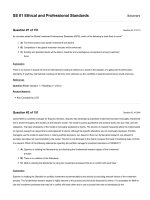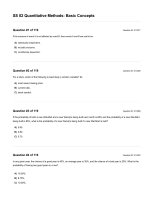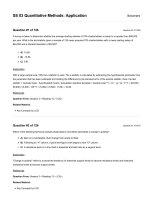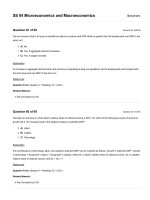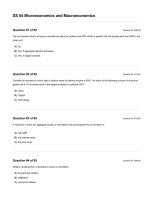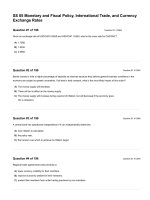CFA 2019 level 1 schwesernotes book quiz bank SS 08 quiz 1
Bạn đang xem bản rút gọn của tài liệu. Xem và tải ngay bản đầy đủ của tài liệu tại đây (515.67 KB, 41 trang )
SS 08 Financial Reporting and Analysis: Inventories, Long-lived
Assets, Income Taxes, and Non-current Liabilities
Question #1 of 143
Question ID: 456301
All-Star Enterprises purchased a machine on January 1. The company uses straight-line depreciation for financial reporting and
accelerated depreciation for tax purposes. Depreciation for tax purposes during the year was $36,000 greater than depreciation
for financial reporting. Assuming a 30% tax rate will apply in the future, how much will be recorded as a deferred tax liability
during the year?
A) $36,000
B) $25,200
C) $10,800
Question #2 of 143
Question ID: 434299
A temporary difference between income tax expense and taxes payable result in a(n):
A) deferred tax item.
B) adjustment to the effective tax rate.
C) gain or loss in comprehensive income.
Question #3 of 143
Question ID: 434313
Compared to issuing a bond at par value, and holding all else equal, when a company issues a bond at a premium, its effect on
the debt/equity ratio will be:
A) no effect on the ratio over the life of the bond.
B) a decreasing trend in the ratio over the life of the bond.
C) an increasing trend in the ratio over the life of the bond.
Question #4 of 143
Question ID: 414625
An analyst compares two companies that are identical except that Company X uses finance leases and Company Y uses
operating leases. The analyst would expect Company X's debt-to-equity ratio, relative to Company Y's, to be:
A) the same.
B) lower.
C) higher.
Question #5 of 143
Question ID: 414594
Which of the following statements regarding zero-coupon bonds is most accurate?
A) A company should initially record zero-coupon bonds at their discounted present value.
B) Interest expense is a combination of operating and financing cash flows.
C) The interest expense in each period is found by applying the discount rate to the book value of debt
at the end of the period.
Question #6 of 143
Question ID: 414533
A tax loss carryforward is best described as the:
A) net taxable loss that can be used to reduce taxable income in the future.
B) net taxable loss that can be used to refund paid taxes from the previous year.
C) difference of deferred tax liabilities and deferred tax assets.
Question #7 of 143
Question ID: 414640
Which of the following statements regarding the effect of a finance lease on the lessee's statement of cash flows is least
accurate?
A) The rental expense serves to reduce the cash flow for financing because it is an investment
expense.
B) The change in the finance lease liability on the balance sheet is a cash flow from financing.
C) The interest expense portion of the lease payments reduces cash flow from operations.
Question #8 of 143
A zero coupon bond, compared to a bond issued at par, will result in higher:
A) cash flows from financing (CFF).
B) cash flows from operations (CFO).
Question ID: 414604
C) interest expense.
Question #9 of 143
Question ID: 434307
Habel Inc. owns equipment with a tax base of $400,000 and a carrying value of $600,000. Habel also has a tax loss carryforward
of $200,000 that is expected to be utilized in the foreseeable future. Deferred tax items on the balance sheet are valued based on
a tax rate of 30%. If the tax rate increases to 35%, the adjustments to the value of deferred tax items will most likely cause
Habel's total liabilities-to-equity ratio to:
A) decrease.
B) increase.
C) remain unchanged.
Question #10 of 143
Question ID: 467388
A bond is issued at the end of the year 20X0 with an 8% semiannual coupon rate, 5 years to maturity, and a par value of $1,000.
The bond's yield at issuance is 10%. Using the effective interest method, if the yield has decreased to 9% at the end of the year
20X1, the balance sheet liability for the bond is closest to:
A) 967.
B) 935.
C) 923.
Question #11 of 143
Question ID: 414643
Penguin Company is planning to lease a $5 million machine to produce goods for eventual sale. Penguin is able to structure the
lease so as to classify it as either an operating or a finance lease. Advantages to Penguin of classifying this lease as an
operating lease are least likely to include that:
A) depreciation is not recorded.
B) the lease is not reported as debt on Penguin's balance sheet, so leverage ratios are not increased.
C) no disclosures of payments due under the lease are required.
Question #12 of 143
A firm purchased a piece of equipment for $6,000 with the following information provided:
Question ID: 414584
Revenue will be $15,000 per year.
The equipment has a 3-year life expectancy and no salvage value.
The firm's tax rate is 30%.
Straight-line depreciation is used for financial reporting and double declining is used for tax purposes.
Calculate taxes payable for years 1 and 2.
Year 1
Year 2
A) 3,300
4,100
B) 3,900
3,900
C) 600
-200
Question #13 of 143
Question ID: 414606
A firm issues a $5 million zero coupon bond with a maturity of four years when market rates are 8%. Assuming semiannual
compounding periods, the total interest on this bond is:
A) $1,600,000.
B) $1,200,000.
C) $1,346,549.
Question #14 of 143
Question ID: 414593
When the market rate is greater than the coupon rate, the bond is called a:
A) discount bond.
B) par bond.
C) premium bond.
Question #15 of 143
Deferred tax liabilities may result from:
A) pretax income greater than taxable income due to permanent differences.
B) pretax income less than taxable income due to temporary differences.
C) pretax income greater than taxable income due to temporary differences.
Question ID: 414574
Question #16 of 143
Question ID: 414600
A bond is issued with the following data:
$10 million face value.
9% coupon rate.
8% market rate.
3-year bond with semiannual payments.
Assuming market rates do not change, what will the bond's market value be one year from now and what is the total interest
expense over the life of the bond?
Value in 1-Year
Total Interest Expense
A) 11,099,495
2,437,893
B) 10,181,495
2,437,893
C) 10,181,495
2,962,107
Question #17 of 143
Question ID: 414637
For a given lease payment and term, which of the following is least accurate regarding the effects of the classification of the lease
as a finance lease as compared to an operating lease?
A) The lessee's current ratio will be higher for a finance lease.
B) The lessee's asset turnover will be lower for a finance lease.
C) The lessee's debt-to-equity ratio will be higher for a finance lease.
Question #18 of 143
Question ID: 414534
If a firm uses accelerated depreciation for tax purposes and straight-line depreciation for financial reporting, which of the following
results is least likely?
A) Income tax expense will be greater than taxes payable.
B) A temporary difference will result between tax and financial reporting.
C) A permanent difference will result between tax and financial reporting.
Question #19 of 143
Question ID: 596409
For analytical purposes, if a deferred tax liability is expected to not be reversed, it should be treated as a(n):
A) an addition to equity.
B) liability.
C) immaterial amount and ignored.
Question #20 of 143
Question ID: 414555
Laser Tech has net temporary differences between tax and book income resulting in a deferred tax liability of $30.6 million.
According to U.S. GAAP, an increase in the tax rate would have what impact on deferred taxes and net income, respectively:
Deferred Taxes Net Income
A) Increase
Decrease
B) No effect
Decrease
C) Increase
No effect
Question #21 of 143
Question ID: 414607
When bonds are issued at a premium:
A) earnings of the firm decrease over the life of the bond as the bond premium is amortized.
B) coupon interest paid decreases each period as bond premium is amortized.
C) earnings of the firm increase over the life of the bond as the bond premium is amortized.
Question #22 of 143
Question ID: 414548
A company purchased a new pizza oven directly from Italy for $12,676. It will work for 5 years and has no salvage value. The tax
rate is 41%, and annual revenues are constant at $7,192. For financial reporting, the straight-line depreciation method is used,
but for tax purposes depreciation is accelerated to 35% in years 1 and 2, and 30% in year 3. For purposes of this exercise ignore
all expenses other than depreciation.
What is the net income and depreciation expense for year one for financial reporting purposes?
Net Income
A) $2,748
Depreciation
Expense
$2,535
B) $4,657
$2,748
C) $2,535
$3,169
Question #23 of 143
Question ID: 479061
Firm 1 has a deferred tax liability and Firm 2 has a deferred tax asset. If the tax rate decreases, the balance sheet values of
these deferred tax items will:
Firm 1
Firm 2
A) increase.
increase.
B) decrease.
decrease.
C) increase.
decrease.
Question #24 of 143
Question ID: 414547
Corcoran Corp acquired an asset on 1 January 2004, for $500,000. For financial reporting, Corcoran will depreciate the asset
using the straight-line method over a 10-year period with no salvage value. For tax purposes the asset will be depreciated
straight line for five years and Corcoran's effective tax rate is 30%. Corcoran's deferred tax liability for 2004 will:
A) decrease by $50,000.
B) decrease by $15,000.
C) increase by $15,000.
Question #25 of 143
Question ID: 596408
When analyzing a company's financial leverage, deferred tax liabilities are best classified as:
A) a liability or equity, depending on the company's particular situation.
B) neither as a liability, nor as equity.
C) a liability.
Question #26 of 143
Question ID: 414545
A firm buys an asset with an estimated useful life of five years for $100,000 at the beginning of the year. The firm will depreciate
the asset on a straight-line basis with no salvage value on its financial statements and will use double declining balance
depreciation for tax. The tax basis for this asset at the end of the first year is closest to:
A) $40,000.
B) $80,000.
C) $60,000.
Question #27 of 143
Question ID: 414576
Which of the following statements best justifies analyst scrutiny of valuation allowances?
A) Changes in valuation allowances can be used to manage reported net income.
B) Increases in valuation allowances may be a signal that management expects earnings to improve in
the future.
C) If differences in taxable and pretax incomes are never expected to reverse, a company's equity may
be understated.
Question #28 of 143
Question ID: 414581
While evaluating the financial statements of Omega, Inc., the analyst observes that the effective tax rate is 7% less than the
statutory rate. The source of this difference is determined to be a tax holiday on a manufacturing plant located in South Africa.
This item is most likely to be:
A) sporadic in nature, but the effect is typically neutralized by higher home country taxes on the
repatriated profits.
B) sporadic in nature, and the analyst should try to identify the termination date and determine if taxes
will be payable at that time.
C) continuous in nature, so the termination date is not relevant.
Question #29 of 143
Question ID: 414598
On December 31, 2004, Newberg, Inc. issued 5,000 $1,000 face value seven percent bonds to yield six percent. The bonds pay
interest semi-annually and are due December 31, 2011. On its December 31, 2005, income statement, Newburg should report
interest expense of:
A) $300,000.
B) $350,000.
C) $316,448.
Question #30 of 143
Question ID: 414550
Unit Technologies uses accrual basis for financial reporting purposes and cash accounting for tax purposes. So far this year, Unit
Technologies has recorded $195,000 in revenue for financial reporting purposes, but, on a cash basis, revenue was only
$131,000. Assume expenses at 50 percent in both cases (i.e., $ 97,500 on accrual basis and $ 65,500 on cash basis), and a tax
rate of 34%. What is the deferred tax liability or asset? A deferred tax:
A) asset of $10,880.
B) liability of $10,880.
C) liability of $16,320.
Question #31 of 143
Question ID: 414608
Which of the following statements for a bond issued with a coupon rate above the market rate of interest is least accurate?
A) The value of the bond will be amortized toward zero over the life of the bond.
B) The bond will be shown on the balance sheet at the premium value.
C) The associated interest expense will be lower than that implied by the coupon rate.
Question #32 of 143
Question ID: 414623
Compared to a finance lease, an operating lease is most likely to be favored when:
A) management compensation is not based on returns on invested capital.
B) the lessee has bond covenants relating to financial policies.
C) at the end of the lease, the lessee may be better able to sell the asset than the lessor.
Question #33 of 143
Question ID: 485781
A health care company purchased a new MRI machine on 1/1/X3. At year-end the company recorded straight-line depreciation
expense of $75,000 for book purposes and accelerated depreciation expense of $94,000 for tax purposes. Management
estimates warranty expense related to corrective eye surgeries performed in 20X3 to be $250,000. Actual warranty expenses of
$100,000 were incurred in 20X3 related to surgeries performed in 20X2. The company's tax rate for the current year was 35%,
but a tax rate of 37% has been enacted into law and will apply in future periods. Assuming these are the only relevant entries for
deferred taxes, the company's recorded changes in deferred tax assets and liabilities on 12/31/X3 are closest to:
DTA
DTL
A) $55,500
$7,030
B) $55,500
$6,650
C) $52,500
$6,650
Question #34 of 143
Question ID: 434312
A company issues an annual-pay bond with the following characteristics:
Face value
$67,831
Maturity
4 years
Coupon
7%
Market interest rates
8%
What is the unamortized discount at the end of the first year?
A) $1,750.
B) $1,209.
C) $538.
Question #35 of 143
Question ID: 414651
Other things equal, and ignoring issuance costs, a firm that raises cash by issuing a new bond is most likely to:
A) increase its leverage ratios and increase its coverage ratios.
B) increase its leverage ratios and decrease its coverage ratios.
C) decrease its leverage ratios and increase its coverage ratios.
Question #36 of 143
Year ending 31 December:
Question ID: 414556
2002
2003
2004
$200
$300
$400
50
50
50
$150
$250
$350
$200
$300
$400
75
50
25
Income Statement:
Revenues after all expenses other than depreciation
Depreciation expense
Income before income taxes
Tax return:
Taxable income before depreciation expense
Depreciation expense
Taxable income
$125
$250
$375
Assume an income tax rate of 40% and zero deferred tax liability on 31 December 2001.
The deferred tax liability to be shown in the 31 December 2003, balance sheet and the 31 December 2004 balance sheet, is:
2003
2004
A) $0
$10
B) $10
$0
C) $25
$20
Question #37 of 143
Question ID: 498761
For a company which owns a majority of the equity of a subsidiary, whether to create a deferred tax liability for undistributed
profits from the subsidiary depends on an "indefinite reversal criterion" under:
A) IFRS, but not U.S. GAAP.
B) both IFRS and U.S. GAAP.
C) U.S. GAAP, but not IFRS.
Question #38 of 143
Question ID: 414562
Selected information from Kentucky Corp.'s financial statements for the year ended December 31 was as follows (in $ millions):
Property, Plant & Equip.
10
Accumulated Depreciation
(4)
Deferred Tax Liability
0.6
The balances were all associated with a single asset. The asset was permanently impaired and has a present value of future
cash flows of $4 million. After Kentucky writes down the asset, Kentucky's tax accounts will be affected as follows (the tax rate is
40%):
A) deferred tax liability will be eliminated and deferred tax assets will increase $1.4 million.
B) taxes payable will decrease $800,000.
C) deferred tax liability will be eliminated and deferred tax assets will increase $200,000.
Question #39 of 143
Question ID: 414647
The present value of benefits earned during the current period by participants in a defined benefit pension plan is best described
as the plan's:
A) service cost.
B) past service cost.
C) net pension liability.
Question #40 of 143
Question ID: 414641
The Mader Corporation leases an asset for five years with lease payments of $10,000 per year. If Mader classifies the lease as a
finance lease, which financial statements are affected at the end of the first year?
A) Income statement only.
B) Income statement and balance sheet only.
C) Statement of cash flows, income statement, and balance sheet.
Question #41 of 143
Question ID: 434306
A company purchased a new pizza oven for $12,676. It will work for 5 years and has no salvage value. The tax rate is 41%, and
annual revenues are constant at $7,192. For financial reporting, the straight-line depreciation method is used, but for tax
purposes depreciation is 35% of original cost in years 1 and 2 and the remaining 30% in Year 3. For this question ignore all
expenses other than depreciation.
What is the deferred tax liability as of the end of year three?
A) $1,029.
B) $780.
C) $2,079.
Question #42 of 143
If timing differences that give rise to a deferred tax liability are not expected to reverse then the deferred tax:
Question ID: 414536
A) must be reduced by a valuation allowance.
B) should be considered an increase in equity.
C) should be considered an asset or liability.
Question #43 of 143
Question ID: 414636
If a lease is treated as a finance lease, as compared to being treated as an operating lease, the effect on the lessee's current
ratio and the debt/equity ratio will be an:
Current Ratio
Debt/Equity
Ratio
A) Increase
Decrease
B) Increase
Increase
C) Decrease
Increase
Question #44 of 143
Question ID: 414646
Which of the following is least likely disclosed in the financial statement footnotes of a lessee?
A) A general description of the leasing arrangement.
B) The lease interest rate.
C) The lease payments to be paid in each of the next five years.
Question #45 of 143
Question ID: 414558
The Puchalski Company reported the following:
Year 1 Year 2 Year 3 Year 4
Income before
taxes
Taxable income
$1,000 $1,000
$800
$900
$900
$800
$900 $1,000
Puchalski has no deferred tax asset or liability prior to Year 1. If the tax rate is 40%, what is the amount of the deferred tax asset
or liability reported at the end of Year 3?
A) Liability of $120.
B) Asset of $120.
C) Asset of $80.
Question #46 of 143
Question ID: 414615
Larry Purcell, an entry-level fixed income analyst at Knowlton & Smeades LLC, was discussing debt covenants with his
supervisor, Andy Holzman. During the meeting Purcell made the following statements regarding bond covenants:
Statement 1: If a firm violates any of its debt covenants, the company will immediately go into bankruptcy and the creditors of the
firm will take over the liquidation of its assets.
Statement 2: Debt covenants are important in evaluating a firm's credit risk and to better understand how the restrictions of the
covenants can affect the firm's growth prospects and choice of accounting policies.
With respect to these statements:
A) both are correct.
B) only one is correct.
C) both are incorrect.
Question #47 of 143
Question ID: 498763
A debt covenant is most likely to restrict a firm from:
A) decreasing its common dividends.
B) issuing new common shares.
C) repurchasing common shares.
Question #48 of 143
Question ID: 414566
Given the following data regarding two firms under different scenarios, determine the amount of any deferred tax liability or asset.
Firm 1:
Tax Reporting
Financial Reporting
Revenue
$500,000 Revenue
$500,000
Depreciation
$100,000 Depreciation
Taxable income
$400,000 Pretax income
$450,000
Taxes payable
$160,000 Tax expense
$180,000
$50,000
Net income
$240,000 Net income
$270,000
Firm 2:
Tax Reporting
Revenue
Financial Reporting
$500,000 Revenue
Warranty
$0
expense
Warranty
expense
$500,000
$10,000
Taxable income $500,000 Pretax income
$490,000
Taxes payable
$200,000 Tax expense
$196,000
Net income
$300,000 Net income
$294,000
Firm 1 Deferred Tax:
Firm 2 Deferred Tax:
A) $20,000 Asset
$6,000 Liability
B) $30,000 Asset
$6,000 Asset
C) $20,000 Liability
$4,000 Asset
Question #49 of 143
Question ID: 414628
Which of the following statements about the impact of leases on the financial statements of the lessee is least accurate?
A) Net income is lower in the early years of a finance lease than an operating lease.
B) Cash flow from investing is higher for a finance lease than an operating lease.
C) A finance lease results in higher liabilities compared to an operating lease.
Question #50 of 143
Question ID: 485783
A company issues 5% semiannual coupon, 3-year, $1,000 par value bonds on January 1, 20X0, when the market interest rate is
13.3%. The sale proceeds are $800. Under the effective interest rate method, what amount of interest expense per $1,000 par
value will the company record for the year ending December 31, 20X1?
A) $116.29.
B) $106.40.
C) $66.29.
Question #51 of 143
Question ID: 414644
Which of the following statements regarding finance and operating leases is least accurate?
A) During the life of an operating lease, the rent expense equals the lease payment.
B) For financial reporting of finance and operating leases, no entry is required on the lessee's balance
sheet at the inception of the lease.
C) Asset turnover is higher for the lessee with an operating lease than a finance lease.
Question #52 of 143
Question ID: 414610
On December 31, 20X3 Okay Company issued 10,000 $1000 face value 10-year, 9% bonds to yield 7%. The bonds pay interest
semi-annually. On its financial statements (prepared under U.S. GAAP) for the year ended December 31, 20X4, the effect of this
bond on Okay's cash flow from operations is:
A) -$700,000.
B) -$755,735.
C) -$900,000.
Question #53 of 143
Question ID: 414575
Which of the following situations will most likely require a company to record a valuation allowance on its balance sheet?
A) A firm has differences between taxable and pretax income that are never expected to reverse.
B) To report depreciation, a firm uses the double-declining balance method for tax purposes and the
straight-line method for financial reporting purposes.
C) A firm is unlikely to have future taxable income that would enable it to take advantage of deferred tax
assets.
Question #54 of 143
Question ID: 434304
A company purchased a new pizza oven for $12,676. It will work for 5 years and has no salvage value. The tax rate is 41%, and
annual revenues are constant at $7,192. For financial reporting, the straight-line depreciation method is used, but for tax
purposes depreciation is 35% of original cost in years 1 and 2 and the remaining 30% in Year 3. For this question ignore all
expenses other than depreciation.
What is the tax payable for year one?
A) $1,909.
B) $1,130.
C) $779.
Question #55 of 143
Year:
Question ID: 414583
2002
2003
2004
$200
$300
$400
50
50
50
$150
$250
$350
$200
$300
$400
75
50
25
$125
$250
$375
Income Statement:
Revenues after all expenses other than depreciation
Depreciation expense
Income before income taxes
Tax return:
Taxable income before depreciation expense
Depreciation expense
Taxable income
Assume an income tax rate of 40%.
The company's income tax expense for 2002 is:
A) $60.
B) $0.
C) $50.
Question #56 of 143
Question ID: 414616
Which of the following provisions would least likely be included in the bond covenants? The borrower must:
A) maintain insurance on the collateral that secures the bond.
B) maintain a debt-to-equity ratio of no less than 2:1.
C) not increase dividends to common shareholders while the bonds are outstanding.
Question #57 of 143
Which of the following best describes valuation allowance? Valuation allowance is a reserve:
Question ID: 414535
A) created when deferred tax assets are greater than deferred tax liabilities.
B) against deferred tax liabilities based on the likelihood that those liabilities will be paid.
C) against deferred tax assets based on the likelihood that those assets will not be realized.
Question #58 of 143
Question ID: 434300
An analyst has gathered the following tax information:
Year 1
Year 2
Pretax Income
$60,000
$60,000
Taxable Income
$50,000
$65,000
The current tax rate is 40%. Assume the tax rate is reduced to 30% and the change is enacted at the beginning of Year 2.
In year 1, what are the taxes payable and what is the deferred tax liability (DTL)?
Taxes payable
DTL
A) $20,000
$3,000
B) $24,000
$1,500
C) $20,000
$1,500
Question #59 of 143
Question ID: 460647
A firm needs to adjust its financial statements for a change in the tax rate. Taxable income is $80,000 and pretax income is
$120,000. The current tax rate is 50%, and the new tax rate is 40%. The effect on taxes payable of adjusting the tax rate is
closest to:
A) $4,000.
B) $8,000.
C) $16,000.
Question #60 of 143
Question ID: 414645
Classifying a lease as an operating lease for a lessee, as opposed to a finance lease, will result in:
Current Ratio
A) Lower
Debt/Equity Ratio
Lower
Asset Turnover
Ratio
Higher
B) Higher
Lower
Higher
C) Higher
Lower
Lower
Question #61 of 143
Question ID: 414553
A firm purchased a piece of equipment for $6,000 with the following information provided:
Revenue will increase by $15,000 per year.
The equipment has a 3-year life expectancy and no salvage value.
The firm's tax rate is 30%.
Straight-line depreciation is used for financial reporting and double declining balance is used for tax purposes.
Calculate the incremental income tax expense for financial reporting for years 1 and 2.
Year 1
Year 2
A) $600
-$200
B) $3,300
$4,100
C) $3,900
$3,900
Question #62 of 143
Question ID: 414617
In analyzing disclosures related to the financing liabilities of a company, which of the following disclosures would be least helpful
to the analyst?
A) The present value of the future bond payments discounted at the coupon rate of the bonds.
B) The interest expense for the period as provided on the income statement or in a footnote.
C) Filings with the Securities and Exchange Commission (SEC) that disclose all outstanding securities
and their features.
Question #63 of 143
In a direct-financing lease, the implicit rate is such that the present value of the minimum lease payments:
A) is lower than the cost of the leased asset.
B) equals the cost of the leased asset.
C) equals the sale price of the leased asset.
Question ID: 414631
Question #64 of 143
Question ID: 434311
An firm is issuing a bond with the following characteristics:
Face value = $10.0 million
Annual coupon = 5.6%
Market yield at issuance = 6.5%
5 year maturity
Ignoring flotation costs, at issuance the bond will increase:
A) liabilities by $10.0 million.
B) assets by $9.626 million.
C) cash flow from investing by $9.626 million.
Question #65 of 143
Question ID: 414597
Interest expense is reported on the income statement as a function of:
A) the unamortized bond discount.
B) the market rate.
C) the coupon payment.
Question #66 of 143
Question ID: 414648
An employer offers a defined benefit pension plan and a defined contribution pension plan. The employer's balance sheet is most
likely to present an asset or liability related to:
A) both of these pension plans.
B) the defined benefit plan.
C) the defined contribution plan.
Question #67 of 143
Question ID: 456302
Samson Therapeutics records all leases as operating leases. Compared to recording capital leases, this results in lower:
A) inventory.
B) leverage.
C) expenses.
Question #68 of 143
Question ID: 414630
According to U.S. GAAP, which of the following would least likely require a lessee to capitalize a lease?
A) The lease term is 75% or more of the estimated life of the leased asset.
B) The present value of the minimum lease payments is 90% or more of the fair value of the leased
asset.
C) The lessee has an option to purchase the asset for its fair market value at the end of the lease.
Question #69 of 143
Question ID: 414559
Graphics, Inc. has a deferred tax asset of $4,000,000 on its books. As of December 31, it became more likely than not that
$2,000,000 of the asset's value may never be realized because of the uncertainty of future income. Graphics, Inc. should:
A) reverse the asset account permanently by $2,000,000.
B) not make any adjustments until it is certain that the tax benefits will not be realized.
C) reduce the asset by establishing a valuation allowance of $2,000,000 against the asset.
Question #70 of 143
Question ID: 414629
Which of the following is least likely one of the criteria under U.S. GAAP for classifying a lease as a finance lease? The:
A) lease contains a bargain purchase option.
B) term of the lease is 75% or more of the estimated economic life of the leased property.
C) lessor retains ownership of the property at the end of the lease term.
Question #71 of 143
Which of the following statements is least accurate? When a bond is issued at a discount:
A) the interest expense will increase over time.
B) cash flows from financing will be increased by the par value of the bond issue.
C) the interest expense will be equal to the coupon payment plus the amortization of the discount.
Question ID: 414605
Question #72 of 143
Question ID: 414589
Proceeds from issuing a bond are recorded on the statement of cash flows as an inflow from:
A) investing (CFI).
B) financing (CFF).
C) operations (CFO).
Question #73 of 143
Question ID: 414588
Assuming all else equal, if the coupon rate offered on a bond is less than the corresponding market rate of interest, the bond will be issued
at:
A) par.
B) a discount.
C) a premium.
Question #74 of 143
Question ID: 434310
A company issues an annual-pay bond with a face value of $135,662, maturity of 4 years, and 7% coupon, while market interest
rates for its bonds are 8%. What is the unamortized discount at the end of the first year?
A) $1,209.
B) $538.
C) $3,495.
Question #75 of 143
Question ID: 414586
A tax rate that has been substantively enacted is used to determine the balance sheet values of deferred tax assets and deferred
tax liabilities under:
A) IFRS only.
B) U.S. GAAP only.
C) both IFRS and U.S. GAAP.
Question #76 of 143
Question ID: 434308
Christophe Inc. is an electronics manufacturing firm. It owns equipment with a tax basis of $800,000 and a carrying value of
$600,000 as the result an impairment charge. It also has a tax loss carryforward of $300,000 that is expected to be utilized within
the next year or two. The tax rate on these items is 40% but the tax rate will decrease to 35%. Which of the following is closest to
the effect on the income statement of the change in tax rate?
A) Decrease income tax expense by $5,000.
B) Increase income tax expense by $25,000.
C) Increase income tax expense by $5,000.
Question #77 of 143
Question ID: 414627
Which of the following statements that classify a lease as a finance lease under U.S. GAAP is least accurate?
A) The present value of the lease payments is at least 80% of the fair market value of the asset.
B) Title is transferred at the end of the lease period.
C) A bargain purchase option exists.
Question #78 of 143
Question ID: 485782
A firm has deferred tax assets of $315,000 and deferred tax liabilities of $190,000. If the tax rate increases, adjusting the value of
the firm's deferred tax items will:
A) decrease income tax expense.
B) increase income tax expense.
C) have no effect on income tax expense.
Question #79 of 143
Question ID: 414602
Nomad Company issued $1,000,000 face value 2-year zero coupon bonds on December 31, 20X2 to yield 8% interest. Bond
proceeds were $857,339. In 20X3 Nomad recorded interest expense of $68,587. In 20X4 Nomad recorded interest expense of
$74,074 and paid out $1,000,000 to redeem the bonds. Based on these transactions only, Nomad's Statement of Cash Flows
would show cash flow from operations (CFO) of:
A) zero in all years.
B) -$142,661 in 20X4.
C) -$68,587 in 20X3 and -$74,074 in 20X4.
Question #80 of 143
Question ID: 414639
If a lessee enters into a finance lease rather than an operating lease, it can expect to have a:
A) higher debt-to-equity ratio.
B) lower debt-to-equity ratio.
C) higher return on assets.
Question #81 of 143
Question ID: 652916
Permanent differences between taxable and pretax income:
A) are considered as changes in the effective tax rate.
B) can be deferred in some cases.
C) are not addressed specifically in the financial statements.
Question #82 of 143
Question ID: 414587
Under IFRS, deferred tax assets and deferred tax liabilities are classified on the balance sheet as:
A) noncurrent items.
B) current items.
C) either current or noncurrent items.
Question #83 of 143
Question ID: 414531
Which of the following statements about tax deferrals is NOT correct?
A) A deferred tax liability is expected to result in future cash outflow.
B) Taxes payable are determined by pretax income and the tax rate.
C) Income tax paid can include payments or refunds for other years.
Question #84 of 143
Question ID: 598674
Assume a city issues a $5 million semiannual-pay bond to build a new arena. The bond has a coupon rate of 8% and will mature
in 10 years. When the bond is issued its yield to maturity is 9%. Interest expense in the second semiannual period is closest to:
A) $80,000.
B) $210,830.
C) $106,550.
Question #85 of 143
Question ID: 414560
An analyst gathered the following information about a company:
Taxable income = $100,000.
Pretax income = $120,000.
Current tax rate = 20%.
Tax rate when the reversal occurs will be 10%.
What is the company's tax expense?
A) $22,000.
B) $24,000.
C) $10,000.
Question #86 of 143
Question ID: 434303
An analyst gathers the following data for Alice Company:
Alice Company reported a pretax income of $400,000 in its income statement for the period ended December 31, 20X2.
Included in its pretax income are: (1) interest received on tax-free municipal bonds $50,000 and (2) rent expense of $20,000.
Only $10,000 was paid in cash for rent during 20X2.
Alice follows cash basis for tax reporting.
Alice's tax rate is 40%.
Based on the information provided, which of the following is most accurate with respect to deferred tax during 20X2? Alice's
deferred tax:
A) asset will increase by $4,000.
B) will remain unchanged.
C) liability will increase by $4,000.
